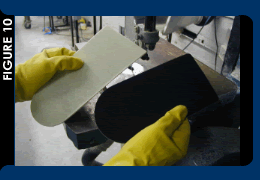Performance Laboratories believes that applying the right orthotic technology is most effective when targeting individual patient requirements.
All of our Laboratory Standards are suggestions only and can be reconfigured on the last page of our order form.
Our experienced staff of orthotic technicians are available to help walk you through the decision making process.
FUNCTIONALCAST PREPARATION / LAB STANDARDS
 |
 |
| Negative casts of the feet are evaluated and set on a level surface. | Blue Plaster is poured into the negative cast. The positive cast is formed and the negative is removed. A pin is inserted in the center of the 1st metatarsal head. A bisection line is drawn at the posterior heel that represents calcaneal position. |
 |
 |
| The inserted pin at the 1st metatarsal head is set so it positions the casts heel bisection line to be perpendicular to the level surface it was set on. The forefoot deformity is now realized by evaluating the amount the pin is extended outward from the cast. The top of the cast is planed so it is also perpendicular with the heel bisection line |
White plaster is added and contoured to the top of the pin to create the slope for the intrinsic post that will correct the forefoot deformity. Plaster is added to other areas of the positive cast to allow for fat pad expansion upon weight bearing. Orthotic parameters are established and drawn on the corrected positive. |
 |
 |
| Shell material is thermoformed to the corrected positive cast and cut to the specified parameters. |
A rearfoot post is adhered to the shell and planed so that it positions the positive casts rearfoot bisection line at 4 degrees inverted lab standard. |
CAST PREPARATION / LAB STANDARDS
 |
|
| The positive cast (Fig 2) is left uncorrected and flexible shell material is formed to it. Filler material is adhered from the heel to the forefoot on the bottom of the shell material. The filler material in the forefoot is planed so that it positions the positive casts rearfoot bisection line at perpendicular. The rearfoot filler material is then planed so that it positions the rearfoot bisection line at 4 degrees inverted lab standard. See Fig 6 |
EXTRINSIC POSTS & MATERIALS / LAB STANDARDS
 |
|
| White post material as seen on top in Fig 8 is extra firm 65 Durometer SBR, which is our standard post material and is capped with 1/16 polyethylene to prevent wear. Tan post material as seen on the bottom in Fig 8 is medium density 45 Durometer EVA. Standard on the FormFlex only pictured in the device section.
Rearfoot Values Lab Standard Extrinsic Rearfoot Posting - Lab standard is 4 degrees inverted. Orthotics with extrinsic posts are pictured in the device section of this site. All substitutions or additions must be selected on the orderform in the "Posting" section. Intrinsic Rearfoot Posting - Lab standard is 3 degrees inverted. Orthotics with intrinsic posts are pictured in the device section of this site. All substitutions or additions must be selected on the orderform in the "Posting" section. |
ORTHOTIC SHELL MATERIALS / LAB STANDARDS
 |
|
| Polyethylene as seen in the left hand of Fig 9 is ultra high molecular weight to prevent fracture and is custom extruded in several different gauges. Easy to heat adjust and grind. Lab standards are determined by patient weight. (Always include patient weight on orderform). For patients with weights greater than 220 lbs. add an arch filler, or change selection to a composite such as Interweave or Positive Stride as seen in "Composite Shell Materials" in this section. When selecting a Sport Device choose the High Impact sport version. Polypropylene as seen in the right hand of Fig 9 is stress relieved and is available in 4 different gauges, relative to orthotic type. (See orthotic description in device section). Excellent memory properties. Used in the Esprit Fashion, FormFlex and FormFlex Mold, MCO, and MCO Fashion. |
COMPOSITE SHELL MATERIALS
 |
|
| Two composite shells are available. The Positive Stride shell material, as seen in the left hand of figure 10, is a custom manufactured polypropylene impregnated with fiberglass as a reinforcement. A Performance Labs Exclusive. The use of fiberglass cuts the shell thickness by 40% and allows omni-directional flexing . Considered a rigid device, the Positive Stride is available in three gauges, determined by patient weight.
Interweave shell material, as seen in the right hand of figure 10, is an acrylic and graphite composite shell. It cuts the thickness of acrylic by 60% and enhances the acrylics ability to reduce fracture. The graphite weave is directional at a 45 degree angle across the shell providing rigidity and strength with the flow of the gait cycle. Thickness is determined by patient weight. Three gauges are available. |

